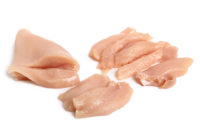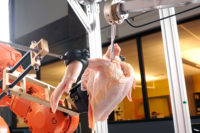Yield is key to profitability. Just as in other areas of processing, cutting and deboning have a direct impact on yield and, in turn, quality. As such, more attention is being paid to this area of processing with different methods in play working to improve yield and quality.
One method processors are using to track yield is using some type of online yield measurement system. “I see a lot more companies having someone at the end of the line doing a scrape test on the carcasses and then reporting yield,” says Gary McMurray, chief of Georgia Tech Research Institute’s (GTRI) Food Processing Technology Division, Atlanta. “They are putting up monitors on the production floor that’s stating the average yield of each of the processing lines with the goal of driving yield. People are aware of how they are actually doing, and they are rewarding the processing lines that have the most yield.”
While yield measurement systems help make workers more aware and drive yield, they also direct processors to where additional training is needed. Processors continue to make training a priority in cutting and deboning. Lines have always been set aside for the training of new employees, but processors are putting more effort into further training of employees to do the cuts. In addition, training has improved in the industry as it goes through cycles of automation and then back to manual cutting and deboning.
“Every time they go back to manual it’s usually because of yield,” McMurray says. “This just emphasizes how important yield of the breast meat is. They have realized that training can help them do that to get the yield that they want. I see them emphasize more training to be able to get that yield.”
Training is also important to employee safety and to food safety. Both have increased dramatically over the last few decades, but both are in a continual improvement process, McMurray says.
Manual vs. automation
In the cutting and deboning process, not many processors use automation. Many processors did try to automate, McMurray says, but then went away from it because of yield.
“You see companies trying to automate little tasks within the whole process where they might try to improve the wing segmenting and things like this,” he says. “The actual cutting and deboning is still very manual because of the variation in the product.”
McMurray would like to move beyond the word “automation” because it implies mechanization, which is usually fixed. On the other hand, the term “robotics” implies that the mechanism can adjust to the particular product or what is unique about a particular bird. Researchers at GTRI are trying to make robotics that adapt to every bird.
“I think right now what we have are fixed automation solutions,” he says. “You set your line to be a certain depth of a cut or the width to be a certain width, and you turn a dial, lock it down and then you run. God help you if that bird is not where you think it should be. I think what is going to be necessary is the robotic solution where you can adapt to every bird. It’s a lot size of one, because that’s what it is. That’s the future, and I would apply that to all of poultry processing.”
Currently GTRI is developing a cutting system that uses a robotic arm, which when commercialized will use a series of small actuators doing motions less than 3 cubic inches.
“It’s not a big area that you have to move the blade on each side of the bird, so you can visualize a relatively small system to be able to do this, because you just don’t need large motions,” McMurray explains. “To me, that is going to be the future.”
When processors moved back to manual lines, many companies still tried to incorporate new technology to improve the cutting and deboning process, particularly incorporating more data.
“You can’t run a plant if you don’t have good data,” McMurray says. “A lot of times, that’s one of the things that is just lacking; they lack real-time data to be able to make decisions in a manufacturing facility.”
Many times the time delay between the data being taken and being displayed is hours. This makes it hard to supervise and make real-time decisions, McMurray says. Real-time data on machines allows processors to know the up-time, the yield and how many mistakes the machine made. In addition, processors can track it in real time, they know how long the product is on the floor, and if something deviates, then the tracking system notifies that something is not going right.
“You walk through a plant that does poultry processing, and they don’t know some of those things,” McMurray says. “That has a huge impact, and if you look at deboning, it’s just one of those places that the more information you have, the better decisions you can make. If you are running a manual line, but ... you are going to automate it, then all that data is even more valuable to you and should be even more prevalent.
“If you really want to say ‘yield is key,’ and that’s what makes or breaks your company, then having data systems to help you optimize is absolutely critical,” he adds.





Report Abusive Comment